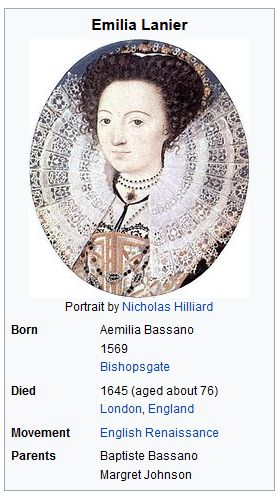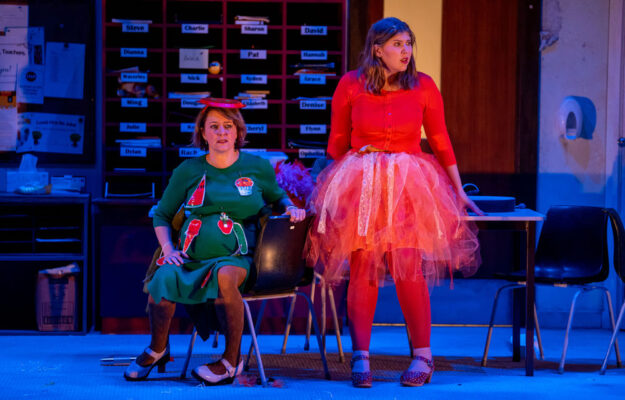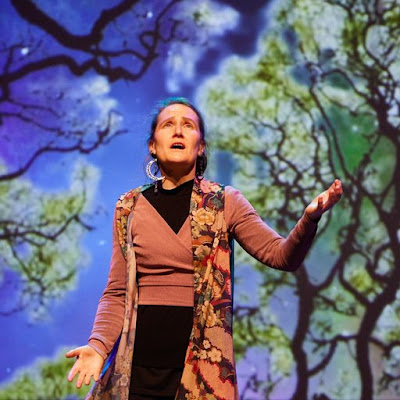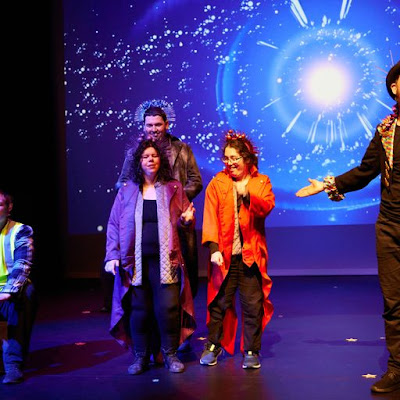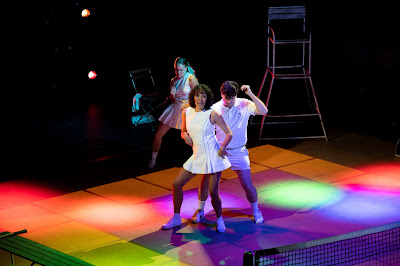The Tempest by William Shakespeare. Sydney Theatre Company at Roslyn Packer Theatre, November 15 – December 21, 2022.
Reviewed by Frank McKone
December 10
Director Kip Williams
Set Designer Jacob Nash
Costume Designer Elizabeth Gadsby
Lighting Designer Nick Schlieper
Composer & Sound Designer Stefan Gregory
Dramaturg Shari Sebbens
Associate Director Jessica Arthur
Fight & Movement Director Nigel Poulton
Associate Fight & Movement Director Tim Dashwood
Intimacy Coordinator Chloë Dallimore
Voice & Text Coach Charmian Gradwell
Cast:
Ariel – Peter Carroll; Antonio – Jason Chong; Sebastian – Chantelle Jamieson
Alonso – Mandy McElhinney; Ferdinand – Shiv Palekar
Prospero – Richard Roxburgh; Miranda – Claude Scott-Mitchell
Caliban – Guy Simon; Stephano – Aaron Tsindos; Gonzalo – Megan Wilding
Trinculo – Susie Youssef
Understudies – Danielle King; Ian Michael; Nicole Milinkovic
Photos – Daniel Boud
 |
| Shive Palekar and Claude Scott-Mitchell as Ferdinand and Miranda in The Tempest by William Shakespeare Sydney Theatre Company 2022 |
A 1972 Performance Syndicate production of The Tempest received critical and popular acclaim, being remounted and taken on tour until 1974.
Australian Dictionary of Biography, Volume 19, 2021 https://adb.anu.edu.au/biography/cramphorn-rex-roy-15453
Because The Tempest
has played a leading role in my working life as a drama teacher, and
later as theatre reviewer, I was not as enthusiastic as the rest of the
audience seemed to be when the final spotlight faded on Richard
Roxborough, standing atop his rock, as Prospero, appealing to us “In
this bare island…release me from my bands…With the help of your good
hands…[or else] my ending is despair”.
Rex Cramphorn was
born on 10th January 1941, one day younger than me and tragically died
of AIDs in 1991. The influence of that 1972 production, taking up the
work of Peter Brook and especially Jerzy Grotowski’s “Poor
Theatre” approach, was the basis of the group improvisation workshop
teaching format which I and, over some 16 years, several colleagues
developed, reaching its climax in the 1992 Hawker College Drama course.
Our public performances had begun in 1976 with The Tempest using
mime and group sound effects to a narration by Prospero, the students
working with a local community group, Melba Players. The always-present
cast encircled Prospero, representing the island, moving into his space
for action and out to the edge as scenes required. The
student-designed backdrop showed a huge almost menacing eye watching.
Sydney Theatre Company grew out of the National Institute of Dramatic Art (NIDA) with Richard Wherrett
as first artistic director in 1979. I attended a professional
development workshop with Wherrett, who had worked with Cramphorn in
Nimrod Theatre, including a 1977 production of The Duchess of Malfi. Peter Carroll, playing Ariel wonderfully today, was in that production, while in the year before John Bell had directed A Handful of Friends at Nimrod.
I sat with Bell to watch his Bell Shakespeare production of The Tempest in 2015 (reviewed here August 29, 2015).
Two
aspects I found to be missing in Kip Williams’ production, which lost
connection with my expectations from this history. To quote my Bell
review:
First: “It was the creation of a spirit world that had
inspired me about Cramphorn’s work. It was a world of philosophic
enquiry, where the island became the universe, a place of wonder and
mystery….Though Cramphorn (and I) had kept all our actors in the circle
on stage throughout, as if there were no other place to be, even for
those not active in the scene, Bell used the circle as an ever-changing
space into and out of which characters come and go….and the movement
exciting and telling: the balance between fantasy and reality, or rather
the fact that both exist at one and the same time, is made in the
movement design and the capacity of the actors to work as dancers….”
Second:
Bell “shows us Miranda as the girl brought up in the wild – she hisses
at Caliban with animal ferocity. Now the hormones of developing
sexuality lock her onto the quite proper young man, Ferdinand.” And
shows us Caliban “representing rebellion. It makes him a genuinely
serious threat to Miranda’s safety, which Prospero must defend, while we
also realise that Caliban is justified in hating Prospero, in parallel
to Ariel’s position – though Ariel is more like an indentured labourer,
while Caliban is enslaved.”
In today’s presentation, with the
island so dominated by the rock, and the circle established only at the
very end by fire, the island becomes not so much a “universe, a place of
wonder and mystery” as a place of threat and fear where dancing and our
enthusiastic clapping have little effect.
On another hand,
today’s Caliban is angry because his ownership of the island is stolen
from him, just as in Shakespeare’s play – but Shakespeare’s view is
uncompromising. Those in power will never give the land back. Caliban
(and even the naïve comics Stephano and Trinculo) are chased off with no
mercy. Prospero makes it clear to Ariel: “Let them be hunted soundly.
At this hour / Lies at my mercy all mine enemies.” There is no Gough
Whitlam pouring sand into the hand of Vincent Lingiari. The best for
Caliban finally is to accept Prospero’s pardon – can you believe?
The irony of Prospero’s final appeal to us is lost in this production of The Tempest.
“As you from crimes would pardon’d be,/ Let your indulgence set me
free”. Kip Williams’ Prospero, who gives Caliban his island back, is a
romance at best. Shakespeare knew he wouldn’t, and knows that
possession is ten points of the law. Caliban can have his island only
because Prospero has regained his Milan and has no more need of the
rock. Why should we indulge him? All he wants is for us not to even
make him say sorry, despite his crime of invading Caliban’s land; and to
praise him for making Caliban think he should “seek for grace”. Whose
grace? It’s as if he has to say sorry to Prospero.
Maybe if we
can get enough of us Prosperos to pass the proposed referendum for the
Voice from the Heart, we might prove Shakespeare wrong.
The odd effect of making this The Tempest
more of a political play than a philosophical play is that the style or
presentation is technically brilliant, in lighting, sound effects, and
real flames (which was perhaps how Shakespeare’s Globe Theatre burnt
down), but the detail of the words and Shakespeare’s use of language was
too often lost. In the very first storm scene, yelling in fear of the
lightning overcame the play between Gonzales, Sebastian, Antonio and the
Boatswain, with the Boatswain trying to get the upper class passengers
out of the way so he can get on with his job of saving them, if
possible.
Prospero’s telling of his story to Miranda became, as
she says: “Your tale, sir, would cure deafness”, as a teenager might
carry on; but the problem was that I couldn’t follow the story either as
it was pumped out at her, rather than being the lengthy (to her
interminable) expression of his feelings about what happened. He tries
hard to explain everything to her, as Shakespeare wrote it. Although
she may get bored, we must not be. But, I’m sorry to say, I was,
because I didn’t hear and sense his feelings at each point.
In
terms of theatrical effect the production is outstanding for the most
part, though I did think the music was sometimes less prominent in the
soundscape than it should have been. But in terms of drama effect – of
our emotional responses to what characters were saying and how they were
behaving – it was Stephano, Trinculo and Caliban who made it through to
me best, until the very end. The final speech by Prospero, isolated on
his rock, with its background rumbling thunder, made it through and, I
think, was the effect that made the applause happen – and continue as
the cast took to the stage around the rock.
So my feelings about the show as a whole are mixed. Kip Williams writes “Nature is a pivotal character in any reading of The Tempest,
and in our production we have sought to bring this aspect of the text
to the very fore.” As I see it, Nature is the spirit, wonder and
mystery, but the text and the subtleties of expression and emotions –
the details – of the relationships between the characters have to be to
the very fore.
 |
| The ring of fire in The Tempest Sydney Theatre Company 2022 |
© Frank McKone, Canberra






